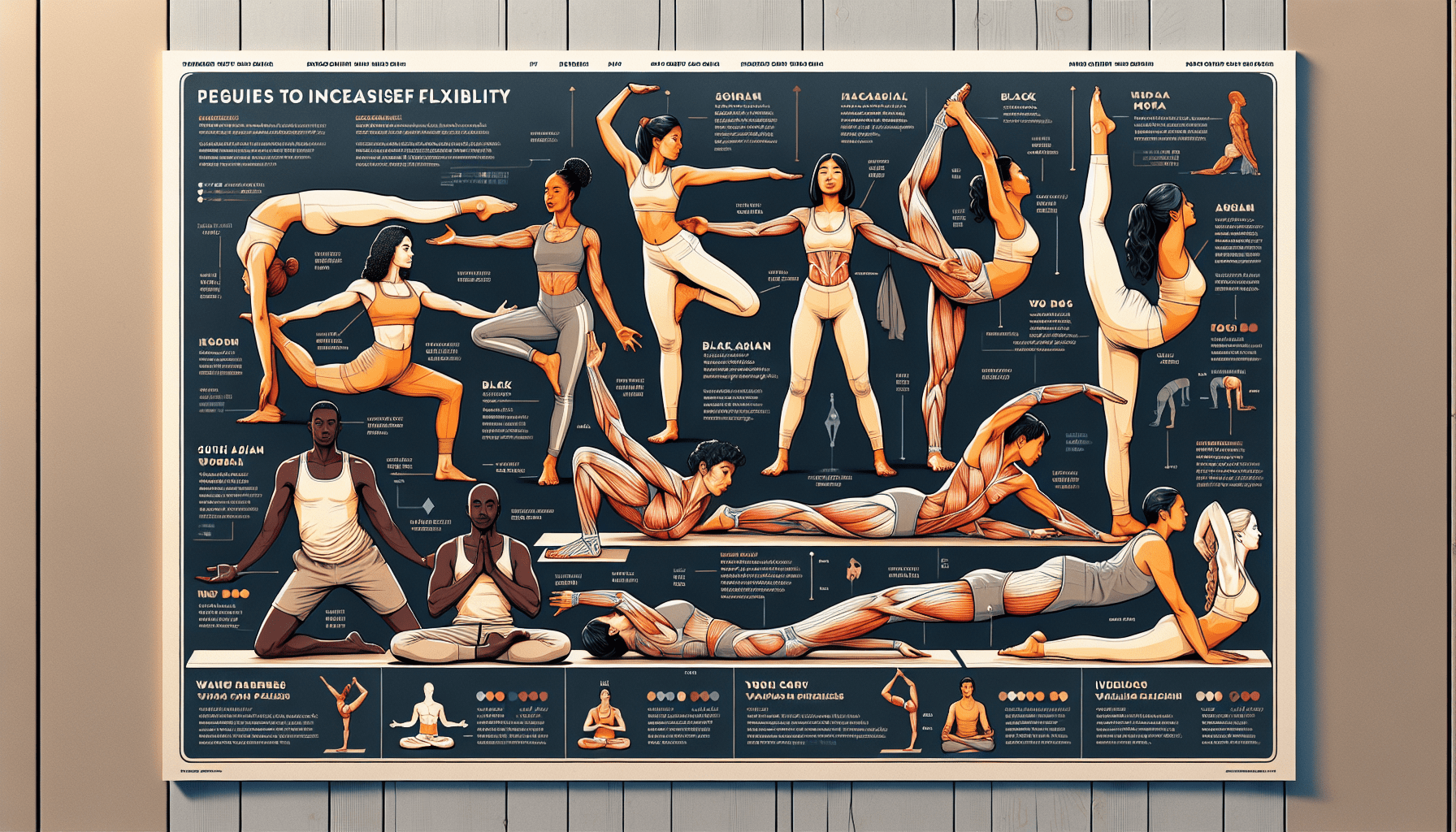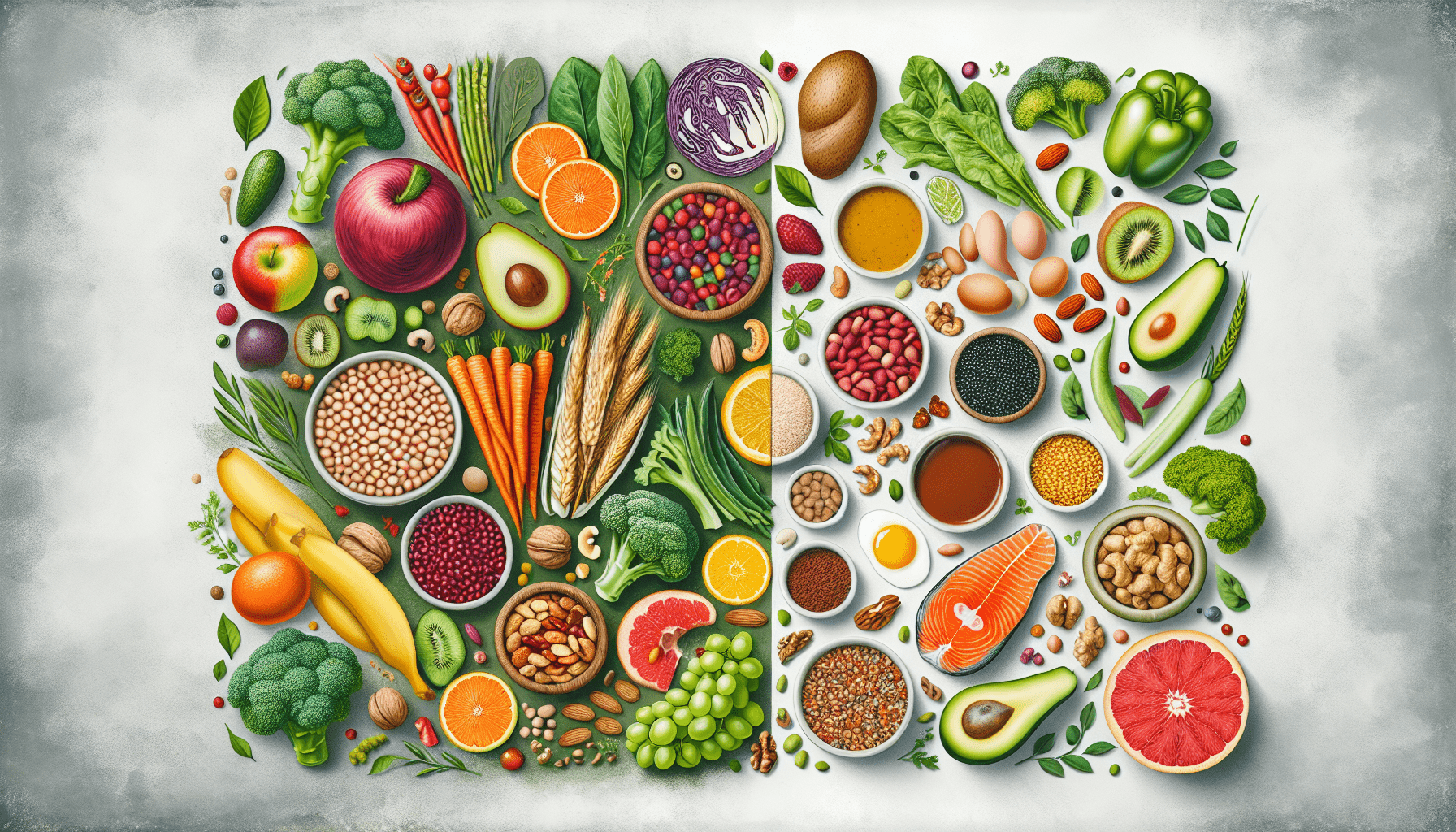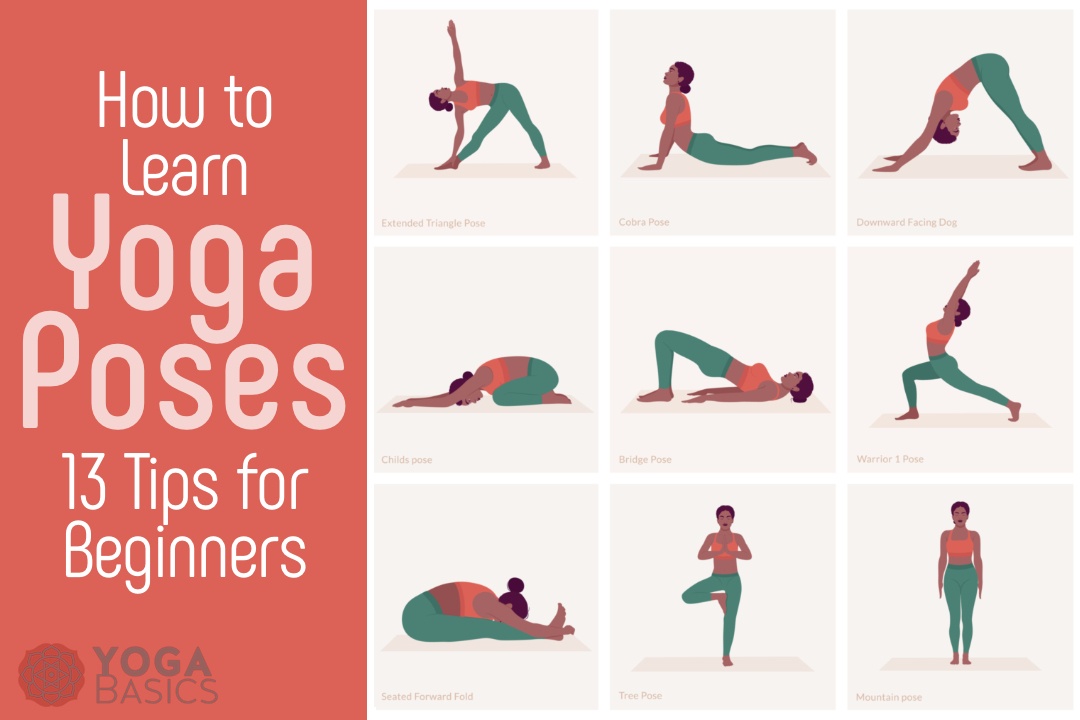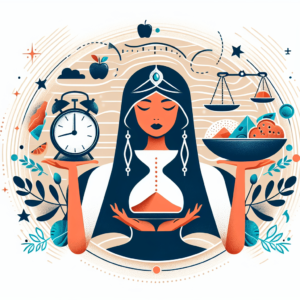Are you looking to improve your flexibility while also finding inner peace? Look no further than yoga poses for flexibility. Whether you are a beginner or an experienced yogi, these poses can help you increase range of motion and loosen up tight muscles. From downward dog to child’s pose, the article “Yoga Poses For Flexibility” will guide you through various poses that will leave you feeling more flexible and relaxed. So roll out your mat, take a deep breath, and get ready to embark on a journey towards a more flexible you.

1. Standing Poses
Mountain Pose (Tadasana)
Mountain Pose, also known as Tadasana, is the foundation for all standing poses. It may seem simple, but it is a powerful pose that helps to improve your posture, balance, and overall body awareness. To practice this pose, stand tall with your feet hip-width apart, spreading your toes wide and grounding them into the floor. Engage your leg muscles and lengthen your spine while relaxing your shoulders. Take deep breaths and imagine yourself as a strong and stable mountain.
Forward Fold (Uttanasana)
Forward Fold, or Uttanasana, is a great pose to stretch and lengthen your hamstrings and calves. Start by standing with your feet hip-width apart and exhale as you fold forward from your hips. Bend your knees slightly if needed and let your upper body hang down towards the floor. You can grab onto your elbows and gently sway from side to side to release tension in your neck and shoulders. Breathe deeply and allow yourself to surrender to the pose, feeling a gentle release in your lower back and hamstrings.
Triangle Pose (Trikonasana)
Triangle Pose, or Trikonasana, is a wonderful pose to open up your hips and stretch your hamstrings, while also improving your balance. Begin by standing with your feet wide apart, about 3-4 feet. Extend your arms out to the sides and align your heels with each other. Turn your right foot 90 degrees to the right and your left foot slightly inwards. Extend your torso to the right and touch your right hand to your shin, ankle, or the floor outside your right foot. Reach your left arm up towards the ceiling, keeping your gaze towards your fingertips. Keep both legs straight and engage your core as you breathe deeply in this energizing pose.
2. Seated Poses
Bound Angle Pose (Baddha Konasana)
Bound Angle Pose, or Baddha Konasana, is a seated pose that targets the hips and inner thighs. Start by sitting on the floor and bring the soles of your feet together, allowing your knees to fall out to the sides. Sit tall and lengthen your spine while gently pressing your elbows into your inner thighs to deepen the stretch. If you want a deeper stretch, you can gently fold forward from the hips, keeping your spine long. This pose helps to open up the hips and improve flexibility, making it a great choice for stretching after a long day or as part of your daily yoga routine.
Seated Forward Bend (Paschimottanasana)
Seated Forward Bend, or Paschimottanasana, is a pose that stretches the entire back body, including the hamstrings, calves, lower back, and shoulders. Begin by sitting on the floor with your legs extended in front of you. Root your sit bones into the ground and lengthen your spine as you inhale. On the exhale, start to fold forward from the hips, reaching your hands towards your feet or shins. If you have tight hamstrings, you can bend your knees slightly or use a strap to hold onto your feet. Remember to breathe deeply and relax into the stretch, allowing yourself to release any tension in your back and hamstrings.
Half Lord of the Fishes (Ardha Matsyendrasana)
Half Lord of the Fishes, or Ardha Matsyendrasana, is a seated twist that helps to stimulate digestion, relieve lower back pain, and improve spinal flexibility. Start by sitting on the floor and extend your legs in front of you. Bend your right knee and place your right foot on the outside of your left knee. Keep your left leg extended and root your sit bones into the ground. Inhale to lengthen your spine and exhale as you twist towards the right, placing your left elbow on the outside of your right knee. Use your breath to deepen the twist with each exhale and imagine wringing out any tension or toxins from your spine. Repeat on the other side.
3. Backbends
Bridge Pose (Setu Bandha Sarvangasana)
Bridge Pose, or Setu Bandha Sarvangasana, is a gentle backbend that helps to strengthen the back muscles, open up the chest, and improve flexibility in the spine. Start by lying on your back with your knees bent and feet hip-width apart. With your arms alongside your body, press your feet into the ground and lift your hips up towards the ceiling. Keep your thighs parallel and roll your shoulders back, allowing your chest to expand. If you want a deeper stretch, you can interlace your fingers underneath your back and press your fists into the ground. Breathe deeply and hold the pose for a few breaths before gently releasing down.
Camel Pose (Ustrasana)
Camel Pose, or Ustrasana, is a deeper backbend that stretches the entire front body, including the chest, shoulders, abdomen, and thighs. Start by kneeling on the floor with your knees hip-width apart. Place your hands on the back of your pelvis, fingers pointing down. Inhale to lengthen your spine, then exhale as you gently arch your back and start to reach your hands towards your heels. Keep your neck long and gaze towards the ceiling or behind you. If it feels comfortable, you can release one hand to reach for your heel and then the other hand. Breathe deeply and allow yourself to open up and surrender into the pose.
Cobra Pose (Bhujangasana)
Cobra Pose, or Bhujangasana, is a gentle backbend that helps to strengthen the back muscles, increase spinal flexibility, and open up the chest and shoulders. Start by lying on your stomach with your legs extended behind you and the tops of your feet pressing into the ground. Place your hands underneath your shoulders, fingers pointing forward. Inhale and press your palms into the ground, lifting your chest and head up while keeping your lower body grounded. Keep your elbows slightly bent and relax your shoulders away from your ears. Breathe deeply and lift your gaze towards the ceiling, feeling a gentle stretch in your abdomen and chest.
4. Twists
Revolved Triangle Pose (Parivrtta Trikonasana)
Revolved Triangle Pose, or Parivrtta Trikonasana, is a twist that helps to detoxify the body, improve digestion, and enhance spinal flexibility. Start in Triangle Pose with your right foot forward and left foot turned slightly inwards. Keep your right hand on your hip and inhale to lengthen your spine. Exhale as you rotate your torso towards the left, bringing your left hand to the outside of your right foot. Reach your right arm up towards the ceiling and gaze towards your fingertips. Keep both legs straight and engage your core as you breathe deeply in this energizing and detoxifying twist.
Revolved Chair Pose (Parivrtta Utkatasana)
Revolved Chair Pose, or Parivrtta Utkatasana, is a challenging twist that builds strength in the legs, core, and upper body, while also improving balance and spinal flexibility. Start in Chair Pose with your feet together and sit back as if you were sitting on an imaginary chair. Inhale to lengthen your spine and exhale as you place your hands in prayer position at your chest. On your next exhale, twist your torso towards the right, placing your left elbow on the outside of your right knee. Keep your knees pressing together and your spine long as you breathe deeply in this powerful and balancing twist. Repeat on the other side.
Seated Spinal Twist (Ardha Matsyendrasana)
Seated Spinal Twist, or Ardha Matsyendrasana, is a seated twist that helps to improve spinal flexibility, relieve lower back pain, and stimulate digestion. Start by sitting on the floor with your legs extended in front of you. Bend your right knee and place your right foot on the outside of your left knee. Inhale to lengthen your spine and exhale as you twist towards the right, placing your left hand on the ground behind you and your right hand on your right knee. Use your breath to deepen the twist with each exhale and imagine wringing out any tension or toxins from your spine. Repeat on the other side.

5. Hip Openers
Pigeon Pose (Eka Pada Rajakapotasana)
Pigeon Pose, or Eka Pada Rajakapotasana, is a deep hip opener that stretches the hip flexors, glutes, and outer hips. Begin in a high plank position and bring your right knee towards your right wrist, placing your right foot in front of your left hip. Extend your left leg straight back behind you and square your hips towards the front of your mat. Inhale to lengthen your spine and exhale as you fold forward, bringing your chest towards the ground. You can rest on your forearms or use props such as blankets or blocks for support. Breathe deeply and allow yourself to release any tension or tightness in your hips.
Butterfly Pose (Baddha Konasana)
Butterfly Pose, or Baddha Konasana, is a seated hip opener that stretches the inner thighs and groin. Start by sitting on the floor and bring the soles of your feet together, allowing your knees to fall out to the sides. Sit tall and lengthen your spine while gently pressing your elbows into your inner thighs to deepen the stretch. You can stay in an upright position or gently fold forward from the hips, keeping your spine long. This pose helps to relax the muscles in the hips and groins, promoting flexibility and improving circulation.
Wide-Legged Forward Fold (Prasarita Padottanasana)
Wide-Legged Forward Fold, or Prasarita Padottanasana, is a standing pose that helps to stretch and open up the hips, hamstrings, and inner thighs. Start by standing tall with your feet wide apart, around 3-4 feet. Turn your toes slightly inward and place your hands on your hips. Inhale to lengthen your spine and exhale as you fold forward from the hips, allowing your torso to hang down towards the floor. Keep your legs straight and engage your quadriceps to protect the hamstrings. You can grab onto your ankles, the floor, or use a prop such as a block for support. Breathe deeply and surrender to the pose, feeling a gentle release and stretch in your hips and legs.
6. Arm Balances
Crow Pose (Bakasana)
Crow Pose, or Bakasana, is an arm balance that strengthens the arms, wrists, and core muscles, while also improving concentration and balance. Start by coming into a squat position with your feet hip-width apart. Place your hands on the ground shoulder-width apart, spreading your fingers wide for stability. Bend your elbows slightly and place your knees on the outside of your upper arms, as close to the armpits as possible. Shift your weight forward and engage your core muscles as you start to lift your feet off the ground, coming onto your tiptoes. Find your balance and hold the pose for a few breaths before gently releasing down.
Forearm Stand (Pincha Mayurasana)
Forearm Stand, or Pincha Mayurasana, is an inversion that strengthens the shoulders, arms, and core, while also improving balance and focus. Start by coming onto your forearms with your elbows shoulder-width apart, parallel to each other. Interlace your fingers and create a solid base by pressing your forearms into the ground. Walk your feet towards your elbows and lift your hips up towards the ceiling, coming into a Downward Facing Dog position on your forearms. Gently straighten your legs and engage your core as you lift one leg towards the ceiling, then the other. Breathe deeply and find your balance, using the strength of your arms and core to hold the pose.
Side Plank (Vasisthasana)
Side Plank, or Vasisthasana, is an arm balance that strengthens the arms, wrists, shoulders, and core muscles, while also improving balance and stability. Start in Plank Pose with your shoulders directly over your wrists and engage your core muscles. Shift your weight onto your right hand and the outer edge of your right foot, stacking your left foot on top of the right. Lift your left arm towards the ceiling and keep your body in a straight line from head to heels. Press through your right hand and engage your core to maintain stability. Breathe deeply and hold the pose for a few breaths before switching to the other side.
7. Inversions
Headstand (Sirsasana)
Headstand, or Sirsasana, is a powerful inversion that helps to increase circulation, improve focus and concentration, and promote a sense of calm and clarity. Start by kneeling on the ground and interlace your fingers, placing your forearms on the ground in front of you. Place the top of your head on the ground, creating a tripod with your forearms and head. Lift your knees off the ground and walk your feet towards your upper body, keeping your legs straight. Engage your core muscles and slowly lift your feet off the ground, coming into a balanced position. Breathe deeply and find your stability, using your core and arm strength to hold the pose. Release slowly and gently come back to the ground.
Shoulderstand (Sarvangasana)
Shoulderstand, or Sarvangasana, is an inversion that helps to improve circulation, stimulate the thyroid gland, and calm the nervous system. Start by lying on your back with your legs extended and arms along your sides, palms facing down. Inhale to lift your legs up towards the ceiling, using your core muscles and slowly raising your hips off the ground. Support your lower back with your hands and bring your legs overhead, resting your weight on your shoulders. Keep your legs straight and engage your core as you breathe deeply in this rejuvenating inversion. Slowly release the pose by gently lowering your legs back down to the ground.
Handstand (Adho Mukha Vrksasana)
Handstand, or Adho Mukha Vrksasana, is an advanced inversion that strengthens the arms, shoulders, and core muscles, while also improving balance and focus. Start by coming into Downward Facing Dog with your hands shoulder-width apart and your heels pressing towards the ground. Walk your feet towards your hands and place your palms on the ground, fingers spread wide. Shift your weight onto your hands and engage your core as you kick one leg up towards the ceiling, using the strength of your arms to lift your body upside down. Find your balance and hold the pose for a few breaths before gently coming down.
8. Supine Poses
Happy Baby Pose (Ananda Balasana)
Happy Baby Pose, or Ananda Balasana, is a gentle supine pose that stretches the inner thighs, hamstrings, and lower back. Begin by lying on your back and draw your knees towards your chest. Separate your knees and bring them towards your armpits, keeping your ankles aligned with your knees. Grab the outsides of your feet and gently press your knees towards the ground. Rock gently from side to side, massaging your lower back and hips. Breathe deeply and allow yourself to relax and surrender into this playful pose.
Supine Spinal Twist (Supta Matsyendrasana)
Supine Spinal Twist, or Supta Matsyendrasana, is a relaxing pose that helps to release tension in the spine, improve digestion, and promote relaxation. Start by lying on your back with your legs extended. Bend your right knee and place your right foot on the outside of your left knee. Inhale to lengthen your spine and exhale as you gently twist towards the right, placing your left hand on your right knee and extending your right arm out to the side. Keep both shoulders grounded and relax into the twist, using your breath to deepen the stretch and release any tension in your spine. Repeat on the other side.
Legs Up the Wall (Viparita Karani)
Legs Up the Wall, or Viparita Karani, is a restorative pose that helps to reduce stress and anxiety, improve circulation, and promote relaxation. Start by sitting sideways with your right hip against a wall. Slowly lower your back and head onto the ground, extending your legs up against the wall. Relax your arms alongside your body and close your eyes. Breathe deeply and allow your body to release any tension, surrendering to the support of the ground and the wall. Stay in this pose for several minutes, enjoying the therapeutic benefits of this gentle inversion.
9. Balancing Poses
Tree Pose (Vrksasana)
Tree Pose, or Vrksasana, is a balancing pose that improves focus, stability, and strengthens the legs and core muscles. Start by standing tall with your feet hip-width apart and find a focal point to fix your gaze on. Shift your weight onto your left foot and lift your right foot off the ground, placing the sole of your right foot on your inner left thigh, calf, or ankle. Bring your hands together at your heart center or extend your arms overhead, like branches reaching for the sky. Find your balance and breathe deeply as you engage your core and root through your standing foot. Repeat on the other side.
Eagle Pose (Garudasana)
Eagle Pose, or Garudasana, is a challenging balancing pose that challenges your focus, strengthens the legs and core muscles, and opens up the shoulders and upper back. Start by standing tall with your feet hip-width apart. Cross your right thigh over your left thigh, hooking your right foot behind your left calf if possible. Extend your arms out to the sides and cross your left arm over your right arm, bringing your palms together in front of your face. If you can’t hook your foot, simply cross your legs and wrap your arms without hooking. Find your balance and breathe deeply as you engage your core and root through your standing foot. Repeat on the other side.
Dancer’s Pose (Natarajasana)
Dancer’s Pose, or Natarajasana, is a beautiful balancing pose that strengthens the legs and core muscles, opens up the shoulders and chest, and improves flexibility and grace. Start by standing tall with your feet hip-width apart. Shift your weight onto your left foot and bend your right knee, reaching your right hand back to grab onto the inside of your right foot or ankle. Lift your left arm towards the ceiling and find your balance as you kick your right foot into your hand, extending your right leg behind you. Keep your chest lifted and your gaze forward. Breathe deeply and find your center as you embody the grace and beauty of a dancer. Repeat on the other side.
10. Restorative Poses
Child’s Pose (Balasana)
Child’s Pose, or Balasana, is a restorative pose that promotes relaxation, helps to relieve stress and anxiety, and gently stretches the back and hips. Start by kneeling on the ground and bring your knees wide apart while keeping your big toes touching. Sit back on your heels and fold forward, bringing your forehead to the ground and your arms extended in front of you or relaxed alongside your body. Allow your breath to deepen and your body to surrender into the pose. Stay in this nurturing and calming pose for as long as you like, enjoying the restorative benefits it offers.
Corpse Pose (Savasana)
Corpse Pose, or Savasana, is the final pose in a yoga practice that allows your body to integrate all the benefits of the practice, promotes deep relaxation, and helps to reduce stress and fatigue. Start by lying on your back with your legs extended and your arms alongside your body, palms facing up. Close your eyes and bring your attention to your breath, allowing it to deepen and slow down naturally. Relax every muscle in your body and let go of any tension or stress. Allow yourself to surrender completely into the ground and feel supported by the earth beneath you. Stay in this pose for several minutes, feeling a sense of peace and rejuvenation.
Supported Bridge Pose (Setu Bandha Sarvangasana)
Supported Bridge Pose, or Setu Bandha Sarvangasana, is a restorative pose that opens up the chest and shoulders, stretches the hip flexors, and helps to relieve stress and fatigue. Start by lying on your back with your knees bent and feet hip-width apart. Place a bolster or a rolled-up blanket underneath your sacrum, supporting your lower back. Allow your arms to relax alongside your body with your palms facing up. Close your eyes and breathe deeply, relaxing into the support of the bolster or blanket. Stay in this restorative pose for several minutes, feeling a gentle release and opening in your chest and hips.
Incorporating these yoga poses into your practice can greatly enhance your flexibility, strength, and overall well-being. Remember to listen to your body and modify the poses as needed, using props or seeking guidance from a qualified yoga instructor. Whether you’re a beginner or an experienced yogi, these poses offer a wide range of benefits and can be practiced at any time to boost your energy, relieve tension, and bring a sense of calm to your mind and body. So, roll out your mat, take a deep breath, and embark on a journey of self-discovery and transformation through the practice of yoga poses. Namaste!




